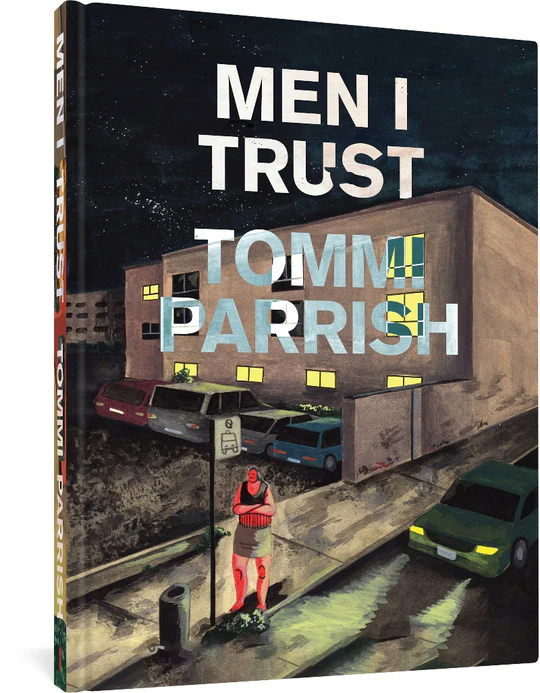A Review of Tommi Parrish’s Men I Trust
By Helena Pantsis
Opening up on a support meeting for alcoholics and people impacted by alcohol, the graphic novel Men I Trust by Tommi Parrish immediately draws you in with its vivid and emotionally cogent watercolour art style. Tackling themes of recovery, gratitude, and queer relationships, Parrish manages to tell stories of vulnerability and create fully rounded characters with merely dialogue and illustration. The work has the reader feeling the stories of the various individuals portrayed in the depths of their chests and the pits of their guts. Through illustrations which shift perspective and focus in on seemingly mundane objects, the power of the everyday is brought to the forefront with this narrative. Earthy colours and brilliant hues enable backgrounds to emphasise the characters in their foreground whilst working equally as hard to provide foundations to the relatable open world of Men I Trust.
The stories of single mother and poet Eliza, and directionless Sasha, who’s just moved back in with her parents, and their blossoming friendship is an authentic reflection of real adults trying to forge new connections. The complexities of loneliness, the links we have to our past, dysfunctional coping mechanisms, and the baggage which comes with who we are in the present, all form the narrative which Parrish expertly depicts in graphic form. Parallel panels highlighting palpable facial expressions, bodily comportments, and subtle gestures ground the reader in the imagery and three-dimensional people who we quickly empathise with and want for.
For example, there is a moment in which Sasha and Eliza are talking on the phone, Eliza discussing a project in which she plans to write a series of poems based on her favourite book, a story where adults give up their autonomy as submissives taken care of by their masters. Listening, Sasha reveals how nice such a life sounds, “having someone close– someone to help share the weight of things.” Two panels, side by side, Sasha lying alone in her bed, Eliza leaning against the kitchen bench, each holding the phone to their ears. Eliza doesn’t respond, and the power of the illustrations reminds us of the irony of the statement. These women, worlds apart, brought together by their shared love of poetry and the struggles of loneliness they each experience, is captured in this simple moment. No other text is needed, and in the following panel, a view of a barely discernible Eliza amongst a series of apartment windows, lets the weight of the vignette settle on our chests with the notion that we are only as alone as we choose to be, sometimes.
Parrish is well aware of the challenges and rewards of the graphic form, with such intricate images, careful lines, and consistent settings all working together in a way that depicts these lives unfolding organically. Exposition isn’t needed to spell things out for us, we gain understanding of the pressures Eliza feels as a single mother and recovering alcoholic, just as we see Sasha’s all-consuming loneliness, her part-time work as a sex worker, and her past suicidality. Utilising intertexts to elevate the work, Parrish is able to weave in advertising, television, radio, and other cartoons to masterful effect. Moreover, the full-page illustrations are reminders of Parrish’s sheer talent. All these elements complement each other with such ease, that it is easy to forget there is no prose weaving the narrative together, but instead an authorial presence and expertise so strong that readers can simply allow the work to flow through them without having their hand held all the while.
For those many of us who’ve undergone the whirlwind that comes with being mentally ill, there is something so heartbreaking and familiar in Sasha’s relationship with her family. “You just keep getting older, and so do we,” is a line that remains with me, as a reprimand from a parent and yet also an existential cry at the core of our beings. A thought that never leaves us. The sadness seeping from both sides of this relationship tells a story from beyond the pages of this text, and reminds us of Eliza’s position with her son Justin, as well.
The climax of the narrative echoes the title of the novel and the very notion of trust itself. And what do we learn about the men we can trust? Maybe they’re our sons, maybe they’re our fathers if we picture them as five-year-olds, maybe they’re the men we used to be, maybe not the men we see on TV, maybe not even the women who come out of nowhere. Men I Trust is a reminder that these relationships are not clear cut, that we define them as they define us. It is a balance between approval and control, boundaries and codependencies, who we are and who we are trying to be.
This text is near impossible to put down once you begin; I devoured the work in a single sitting. Parrish knows how to draw a reader into the complex, all-too human world of their characters and hold them there. Whether you’re a first-time reader of graphic narratives or an already full-fledged fan of the genre, Parrish’s work is captivating for all, and their exploration of several entwined, compelling themes is a true pleasure to bear witness to.


Helena Pantsis
Helena Pantsis (she/they) is a writer, student, and artist from Naarm, Australia. A full-time student of creative writing, they have a fond appreciation for the gritty, the dark, and the experimental. Her works have been published in Overland, Island, Going Down Swinging, and Meanjin. More can be found at hlnpnts.com.
